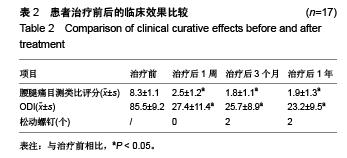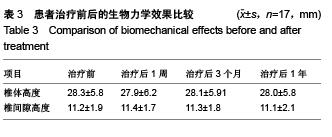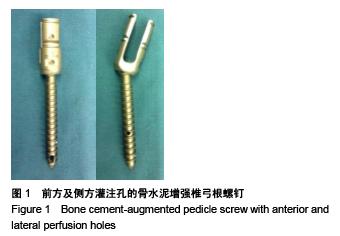| [1] 李鹏,毛克亚,王岩,等.骨水泥强化椎弓根螺钉在腰椎滑脱伴骨质疏松椎体中的临床研究[J].中国骨质疏松杂志,2011, 17(11): 961-963. [2] 范海涛,申才良,董福龙,等.不同强化技术在骨质疏松椎体钉道的力学研究[J].安徽医科大学学报,2012,47(3):342-344. [3] 朱青安,李鉴铁,赵卫东,等.聚甲基丙烯酸甲酯强化和修复椎弓根螺钉的生物力学研究[J].中华骨科杂志,2010, 14(42):7951-7954. [4] 樊仕才,刘世学,邓月兴,等.强化骨质疏松椎弓根螺钉对脊柱稳定性影响的生物力学研究[J].中国修复重建外科杂志,2004, 18(3):168-170. [5] 王栋,冯杰,马超,等.骨水泥强化椎体技术在骨质疏松性脊柱后凸畸形手术治疗中的应用(16例报告)[J].中国矫形外科杂志,2013, 21(17):1792-1795. [6] Liu D, Wu ZX, Pan XM, et al.Biomechanical comparison of different techniques in primary spinal surgery in osteoporotic cadaveric lumbar vertebrae: expansive pedicle screw versus polymethylmethacrylate-augmented pedicle screw. Arch Orthop Trauma Surg. 2011;131(9):1227-1232. [7] Paré PE, Chappuis JL, Rampersaud R,et al.Biomechanical evaluation of a novel fenestrated pedicle screw augmented with bone cement in osteoporotic spines. Spine (Phila Pa 1976). 2011;36(18):E1210-1214. [8] Lee SH, Kim ES, Eoh W.Cement augmented anterior reconstruction with short posterior instrumentation: a less invasive surgical option for Kummell's disease with cord compression.J ClinNeurosci. 2011;18(4):509-514. [9] McLachlin SD, Al Saleh K, Gurr KR,et al.Comparative assessment of sacral screw loosening augmented with PMMA versus a calcium triglyceride bone cement. Spine (Phila Pa 1976). 2011; 36(11):E699-704. [10] Gao M, Lei W, Wu Z,et al.Biomechanical evaluation of fixation strength of conventional and expansive pedicle screws with or without calcium based cement augmentation. ClinBiomech (Bristol, Avon). 2011;26(3):238-244. [11] Choma TJ, Frevert WF, Carson WL,et al.Biomechanical analysis of pedicle screws in osteoporotic bone with bioactive cement augmentation using simulated in vivo multicomponent loading. Spine (Phila Pa 1976). 2011; 36(6):454-462. [12] Bullmann V, Liljenqvist UR, Rödl R,et al.Pedicle screw augmentation from a biomechanical perspective.Orthopade. 2010;39(7):673-678. [13] Liao JC, Fan KF, Keorochana G,et al.Transpedicular grafting after short-segment pedicle instrumentation for thoracolumbar burst fracture: calcium sulfate cement versus autogenous iliac bone graft. Spine (Phila Pa 1976). 2010;35(15):1482-1488. [14] Zhuang XM, Yu BS, ZhengZM, et al. Effect of the degree of osteoporosis on the biomechanical anchoring strength of the sacral pedicle screws: an in vitro comparison between unaugmentedbicortical screws and polymethylmethacrylate augmented unicortical screws. Spine (Phila Pa 1976).2010; 35(19):E925-931. [15] Masaki T, Sasao Y, Miura T, et al. An experimental study on initial fixation strength in transpedicular screwing augmented with calcium phosphate cement. Spine (Phila Pa 1976). 2009;34(20):E724-728. [16] Hu MH, Wu HT, Chang MC,et al.Polymethylmethacrylate augmentation of the pedicle screw: the cement distribution in the vertebral body. Eur Spine J. 2011;20(8):1281-1288. [17] Yu BS, Yang ZK, Li ZM,et al.Which is the preferred revision technique for loosened iliac screw? A novel technique of boring cement injection from the outer cortical shell. J Spinal Disord Tech. 2011;24(6):E49-56. [18] 陈文瑶,李新志. 骨水泥强化椎弓根螺钉固定的研究进展[J].中国矫形外科杂志,2010,18(3):226-229. [19] Moon BJ, Cho BY, Choi EY,et al.Polymethylmethacrylate- augmented screw fixation for stabilization of the osteoporotic spine:a three-year follow-up of 37 patients. J Korean Neurosurg Soc. 2009;46(4):305-311. [20] Aydogan M, Ozturk C, Karatoprak O,et al.The pedicle screw fixation with vertebroplasty augmentation in the surgical treatment of the severe osteoporotic spines. J Spinal Disord Tech. 2009;22(6):444-447. [21] Rahamimov N, Mulla H, Shani A,et al.Percutaneous augmented instrumentation of unstable thoracolumbar burst fractures. Eur Spine J. 2012;21(5):850-854. [22] Sawakami K, Yamazaki A, Ishikawa S,et al. Polymethylmethacrylate augmentation of pedicle screws increases the initial fixation in osteoporotic spine patients. J Spinal Disord Tech. 2012;25(2):E28-35. [23] Mesfin A, Komanski CB, Khanna AJ.Failure of cement-augmented pedicle screws in the osteoporotic spine: a case report. Geriatr Orthop Surg Rehabil. 2013;4(3):84-88. [24] Zhu Q, Kingwell S, Li Z,et al.Enhancing pedicle screw fixation in the aging spine with a novel bioactive bone cement: an in vitro biomechanical study. Spine (Phila Pa 1976). 2012;37(17): E1030-1037. [25] Kim HS, Kim SW, Lee WT.Spondylolisthesis accompanying bilateral pedicle stress fracture at two vertebrae. J Korean Neurosurg Soc. 2012;51(6):388-390. [26] Lubansu A, Rynkowski M, Abeloos L,et al.Minimally invasive spinal arthrodesis in osteoporotic population using a cannulated and fenestrated augmented screw: technical description and clinical experience. Minim Invasive Surg. 2012; 2012:507826. [27] Choma TJ, Pfeiffer FM, Swope RW,et al.Pedicle screw design and cement augmentation in osteoporotic vertebrae: effects of fenestrations and cement viscosity on fixation and extraction. Spine (Phila Pa 1976). 2012;37(26):E1628-1632. [28] Ying SH, Kao HC, Chang MC,et al.Fixation strength of PMMA-augmented pedicle screws after depth adjustment in a synthetic bone model of osteoporosis. Orthopedics. 2012; 35(10):e1511-1516. [29] Fölsch C, Goost H, Figiel J,et al.Correlation of pull-out strength of cement-augmented pedicle screws with CT-volumetric measurement of cement. Biomed Tech (Berl). 2012;57(6):473-480. [30] Koller H, Zenner J, Hitzl W,et al.The impact of a distal expansion mechanism added to a standard pedicle screw on pullout resistance. A biomechanical study. Spine J. 2013;13(5): 532-541. [31] Chao KH, Lai YS, Chen WC, et al. Biomechanical analysis of different types of pedicle screw augmentation: a cadaveric and synthetic bone sample study of instrumented vertebral specimens. Med Eng Phys. 2013;35(10):1506-1512. [32] Chang MC, Kao HC, Ying SH,et al.Polymethylmethacrylate augmentation of cannulated pedicle screws for fixation in osteoporotic spines and comparison of its clinical results and biomechanical characteristics with the needle injection method. J Spinal Disord Tech. 2013;26(6):305-315. |



.jpg)
.jpg)
.jpg)
.jpg)